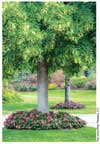| Can trees cut work loss? |
 |
| News |
| Wednesday, March 14, 2018 05:00 AM |
|
A report last year by The Nature Conservancy (TNC), in collaboration with Analysis Group and Trust for Public Land, makes the case for treating trees like part of a city’s public infrastructure. The report, titled “Funding Trees for Health,” demonstrates a connection between urban trees and public health. By connecting the two financially and investing in the urban canopy, cities may create a cost saving in health care and work loss. But most cities in the U.S. are losing trees each year—a national decline of about 1.3 percent or 4 million urban trees. Trees are being lost not just from the natural life cycle, but from development and invasive pests. Working with government and developers to increase the number of trees planted could produce significant benefits to the mental and physical health of residents. Experts estimate an average investment in tree planting of just $8 per resident each year could produce significant results in improved air quality and health outcomes. Denver and Fort Collins “As city populations grow, urban trees cannot be viewed as a luxury: Trees are an essential component of a livable community and a core strategy for improving public health,” notes the study. Fortunately, the City of Denver is currently bucking the urban tree loss trend with a forward-thinking plan for tree replacement—specifically, losses projected from Emerald Asher Borer infestation (see page 13). For now, the plan is funded by the City, which contracted a few landscape companies to assist with planting. The Louisville experiment The challenge to be overcome for cities to invest in trees requires more rigorous scientific studies. This is precisely why a coalition of several organizations has come together in Louisville to conduct a large-scale study on the effectiveness of urban trees on improving air quality and public health. The study, called the Green Heart Project, led by a medical doctor at University of Louisville Medical Center is a large-scale clinical trial testing the hypothesis that trees are a viable therapy—the “pharmaceutical.” Green Heart was launched fall 2017 gathering baseline data on air quality in selected neighborhoods. About 700 people will participate in baseline and ongoing rounds of blood, urine and other testing over five years. In fall 2018, 8,000 trees, shrubs and other plants—including mature specimens—will be planted in selected neighborhoods. It is hoped results of the study will empower more cities and legislators to step up to the investment gap for planting trees to support public health. In the meantime, the green industry will continue its work with commercial, residential and public clients bringing nature to urban settings. Read more in this issue of Colorado Green NOW: |

 It may seem like a stretch to connect having more urban trees to reducing work loss, but researchers are conducting experiments to connect those dots. Early findings suggest tree planting should be more front and center in municipal budgets like fire and police protection because of the tremendous impact trees have on public health.
It may seem like a stretch to connect having more urban trees to reducing work loss, but researchers are conducting experiments to connect those dots. Early findings suggest tree planting should be more front and center in municipal budgets like fire and police protection because of the tremendous impact trees have on public health.